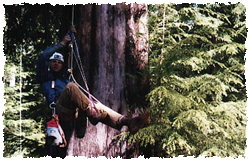Tree Climbing
Insider Info
"Tree climbing is both mentally and physically challenging, fun, relaxing,
and exciting all rolled into one amazing sensation!" says Paul Taylor. He
is a tree climber. He is also president of Arborwear, a store in Ohio that
sells clothing for tree climbers.
Welcome to what many are calling the newest extreme sport. What you may
have done quite naturally as a kid is now a popular recreation enjoyed by
people all over the world. Tree climbing is just what it sounds like: people
climbing trees. Some people, like arborists, climb trees for a living. Others
climb for fun. Some people even climb trees in competitions!
You can climb a tree in a forest, or you can climb the tree in your backyard.
Basically, you can climb anywhere trees exist. Of course, depending on where
the tree is, you may have to ask for permission first.
Ever wonder how many people take part in recreational tree climbing in
North America?
"I'd guess 5,000 to 6,000," says Michael Oxman. He is a tree climber
and certified arborist in Washington.
"Well, I would have to say somewhere between 1,000 and 3,000. I have been
to recreational events here where over 300 have come not to just climb, but
who told their stories of climbing," says Vicki Miller. She is a tree climber
and student in Wisconsin.
"To date, TCI [Tree Climbing International] has introduced well over 10,000
first-time climbers to this activity with no injuries," says Peter "Treeman"
Jenkins. He is a tree climber, certified arborist and the founder of Tree
Climbers International.
As you can see, the answer to that question depends on whom you talk to.
This is because no one really keeps track. The one thing for sure is that
tree climbing is gaining in popularity.
The most notable trend in tree climbing is its growing popularity. Memberships
in various trade organizations like the International Society of Arboriculture
and the National Arborist Association are said to be on the rise.
Another trend involves the equipment used. These days, there is equipment
available that is specifically designed for climbing trees. These special
ropes and harnesses make it easy for people of all ages to climb.
Getting Started
Compared to a lot of other activities, tree climbing doesn't cost
very much. At the very least, all you really need are the basics -- a rope,
a harness or saddle, and an ascending device or pulley. This basic equipment
shouldn't cost you much more than about $500.
Of course, when buying gear, make sure it is of good quality. And make
sure you buy tree climbing equipment, not rock climbing equipment. There are
important differences between the two and you have to think safety first.
Remember: you're literally putting your life out on a limb!
Just about anyone can climb a tree. You don't need to be physically
fit (although it wouldn't hurt). And you don't have to be a natural
climber. What you do need to learn is how to use the equipment properly. This
is absolutely vital! Don't ever attempt a climb without expert supervision.
 |
| With the right equipment and proper supervision, tree climbing can
be enjoyable without being dangerous. |
| Courtesy of: Michael Oxman |
It may not seem possible at first, but people with physical challenges
can also enjoy tree climbing. Of course, it depends on the particular challenge,
but it's truly amazing how many people can take part.
"I do work with the physically challenged. Paraplegics, deaf, and blind
do well. I have also taken quadriplegics up using a counterbalance rope system,"
says Jenkins.
If you start climbing trees, and you really like it, why not turn it into
a good paying job? The most obvious careers that involve tree climbing are
arborists or tree surgeons. "For individuals who aren't afraid to work
hard, there exists awesome opportunities from coast to coast. Tree services
are always looking for qualified climbers, and in many instances are willing
to pay top dollar for them," says Taylor.
Are you hooked on this yet? If you are, it doesn't take much to get
started. The first thing you need to do is find someone who knows the ropes
-- as in an expert teacher. This person should have plenty of tree climbing
experience, and may even be able to supply you with the proper equipment.
Tree Climbing International has certified instructors worldwide. Check
their Web site and see if there is one near you. Failing that, you could also
look up some arborists in your area and see if they would be willing to help
you get started. Remember though, they must be experienced tree climbers!
Like many recreational activities, tree climbing has its share of potential
dangers. The biggest and most obvious risk is to fall out of a tree. This
can be fatal, depending on how high you are or how you fall.
Having said that, bear in mind that tree climbing is very safe, especially
with the equipment available these days. Another potential injury you must
consider when climbing is not to you, but to the tree! You have to remember
that a tree is a living thing, and you must be very careful not to scar or
damage it.
Publications
Every Time I Climb a Tree,
by
David McCord and Marc Simont
Rope Knots and Tree Climbing Safety for Tree Workers,
by
Robert Thompson
Tree Climbing,
by
Susan Mernit
Links
Treeclimbing.com
A comprehensive tree climbing site
Wolf Claw Pole and Tree Climbing Harness
See what the pros use to climb poles and trees
Tree Climbing Japan
The Japanese are into tree climbing, too
Arborwear
Climb trees in the latest fashions
TreeCareJobs.com
If you like to climb trees, and you're thinking of turning
it into a career, this is a good place to look
Back to Career Cluster